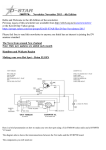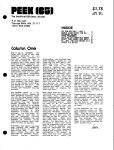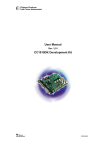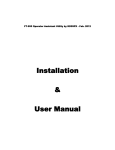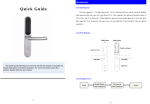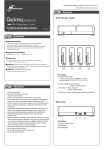Download HM-133 Microphone Mods
Transcript
HM-133 Microphone modification for ICOM IC-2820H and ID-880H. Author: John M Wysocki ZL2TWS August 2012 I purchased an IC-2820H radio fitted with the DV D-Star board UT-123 in 2011. It was with great disappointment to be told that I sounded “metallic” and “tinny” by those that know my voice on FM repeaters. The sound was even worse in DV mode. The challenge was laid down to see if my IC-2820H was a bad audio response or had ICOM just made a bad batch of microphones. There was also an additional problem with the poor quality loud speaker fitted to the rigs. This was an easier problem to solve with simply plugging in an external speaker varying in size from 2 to 4 inches. A surplus car rear parcel shelf speaker gave me a nice quality tone on both FM and DV. Further investigation revealed some startling facts. 1) If you have a look at the back of the microphone it might say Made in China 2) With a Japanese made HM-133, borrowed from an IC208H, it sounded just fine. 3) With a Chinese HM-154T connected it sounded better but still not right. A similar problem. 4) With adaptor cable OPC-589 and an SM-30 desk mic it sounds the best. The challenge was to solve the problem. Forums and discussions regarding the IC-2820H and ID-880H were often related to “poor sounding audio” It would seem to me that some were very pleased and others wanted to “ditch” the radios altogether. It appears that ICOM have out sourced the microphones at some time in the life of the current radio production. If you are lucky you might have a good microphone. The problems are many and varied with the HM-133. Some have taken a lot of time to improve the sound but I have made two changes only. 1) The series coupling capacitor (100nF chip) is too small in value. 2) The microphone capsule seems to be a low output with a felt glued to it. The IC-208H supplied HM-133 did not have felt glued to the face of the capsule. It appears glue has filled the tiny holes and restricted air flow on Chinese mics. The solution was first brought to my attention by a fellow D-Star operator in Hamilton New Zealand. He had contacted ICOM for an alternative supply of capsules. With this information I did the same and placed an order. The capsules that were delivered are from an IC-M15 Marine VHF hand held. ICOM Part number: 7700001750 EM-123TH MIC IC-M15. Unfortunately the solder legs are half the length needed to pass through the PCB. Careful connection of two extension wires is required. At $5 per capsule I was prepared to attempt this. ICOM most probably can supply the correct capsule but when asked for a replacement for the HM-133 I was given the M15 version. Perhaps ask for a capsule from an IC-208H and see what is delivered. How to modify: Stage 1. 1) Open up the mic by removing the rear screws and bringing the cover upwards. 2) If a surface mount bipolar 3u3 or 4u7 capacitor is available sweat solder it across the 100nF. I used 2% silver content solder since I had some in stock. Subsequently I have been told that regular good quality solder is adequate. 3) If a larger type capacitor (circled in BLUE) is to be used prepare it first by cutting and shaping the legs as shown in the picture. Apply F2 contact adhesive or quick setting silicon rubber under the capacitor with the legs positioned over each end of the chip. Try and get the end up against the back cover threaded post. 4) NOTE that the capacitor must be moved side ways so that it clears from the side shell. This stops the lid forcing against the capacitor and cracking the chip and solder pad. The piggy backed 3u3 or 4u7 chip capacitor is the better option. 5) Test the microphone to check if it is working correctly. An audio change will already be noticed as a result of stage 1. Note: Chip cap was Removed and new cap Soldered to pads in this Example. It was found easier to solder parallel to the chip on other mics I modified or use an SMD cap. Stage 2. 1) Shown in the picture above in a RED square is the capsule soldering points. 2) With a solder sucker remove cleanly these solder blobs. 3) Remove the capsule noting the + on the bottom of it. This aligns with a small circle on the PCB. The replacement capsule + will go back in this hole. The capsule can only go in this way to fit into the large PCB circle used as a placement guide. Very hard to get this wrong. Old capsule with glued felt. New capsule fitted but proud about 1mm. 4) 5) 6) 7) Solder extension wires if required (depends on capsule supplied) by securing the new capsule in a soft clamp on the workbench. Use a low temperature iron to sweat two pre-tinned wires to the capsule legs. Mount the capsule and solder. Check that no solder bridge has taken place on the solder side with a meter. Remove with a solder sucker and repeat if it has formed a bridge. You will notice the new capsule sits proud of the board due to the soldered extension wires not passing fully through the PCB. There seems to be plenty of room for the capsule to seat into the front rubberized keypad housing. The old capsule with the felt removed has less holes in the front and just looks to be less efficient than the replacement M15. Test the microphone. Adjust the radio menu option for “mic sens level” to LOW which is the US version default. Other export models like those available in New Zealand have the “mic sens level” on HIGH. The new capsules have a higher output level so LOW should be selected. This might actually indicate that the new capsules are a better wider band audio quality and more efficient. ALC can also be switched on using the LOW setting as detailed in the user manual. Some users have added cotton wool to the cavity formed in the back case. The tone can be modified doing this but not for my voice so I have removed it. The Chinese HM-133 microphones are not expensive to buy online. If ICOM are no longer supplying Japanese made ones you could purchase one to experiment with. Try other capsules. The capacitor increase in value is essential anyway and greatly improves a standard HM-133 and HM-154. The ICOM radios do have a good audio modulation on them and it is simply “rubbish in rubbish out” modifications such as this will improve the DV audio to what it should be. Many users have now commented how good the audio is and how pleasant it is to listen to now. This improvement can only add value to the whole DV experience. If you like to use a desk microphone I recommend the SM-30 and the OPC-589 adaptor cable. This limits the radio to front panel control with the loss of the remote functions. I have found this a good way to operate the radio and become more familiar with its features. 73 and good DV. John ZL2TWS.



